The MacBook Pro Review (13 & 15-inch): 2011 Brings Sandy Bridge
by Anand Lal Shimpi, Brian Klug & Vivek Gowri on March 10, 2011 4:17 PM EST- Posted in
- Laptops
- Mac
- Apple
- Intel
- MacBook Pro
- Sandy Bridge
At medium settings, it's a bit worse, but L4D2, Mass Effect, STALKER, and SC2 remain almost playable. Battlefield and DiRT, not so much. Overall, we see performance goes down from the 320M by just under 20% on average (not counting StarCraft, which is again marginally faster due to the reliance on CPU performance).
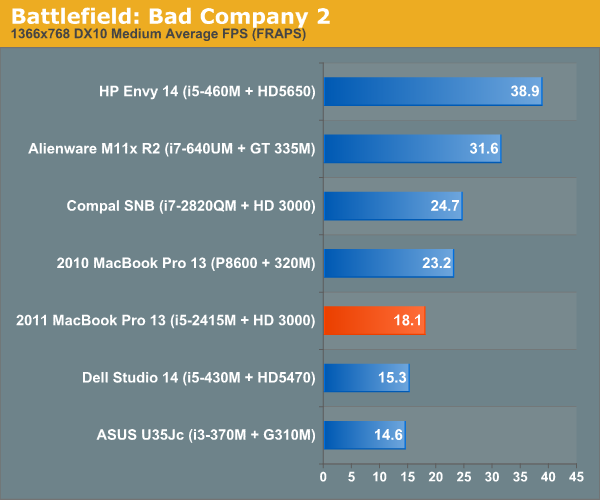
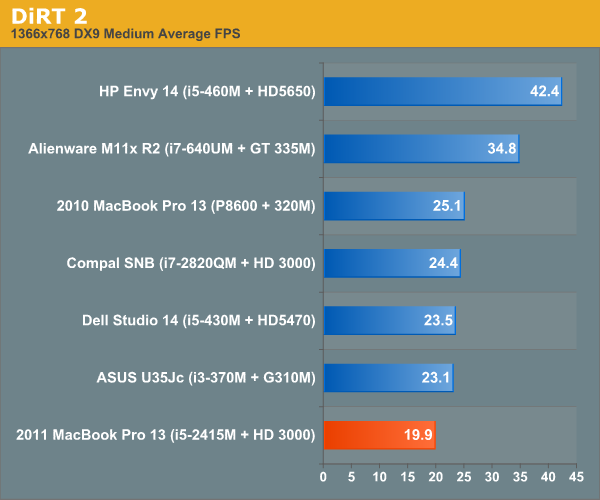
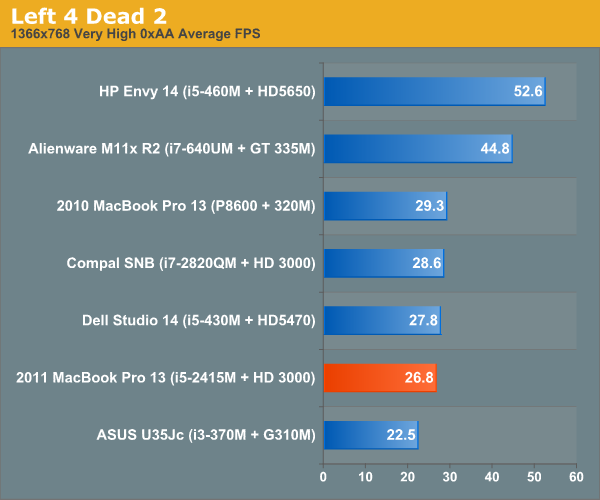
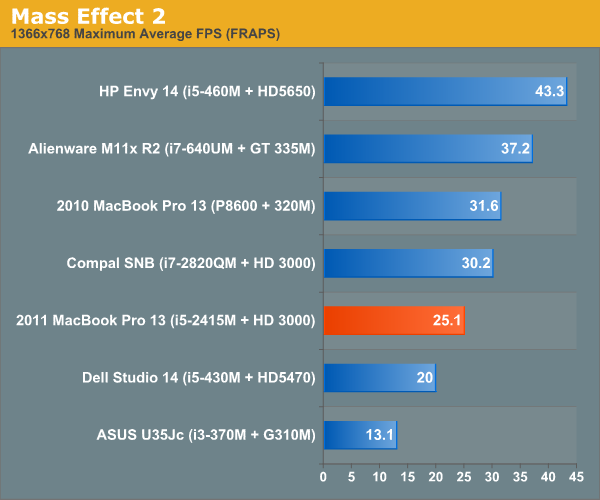
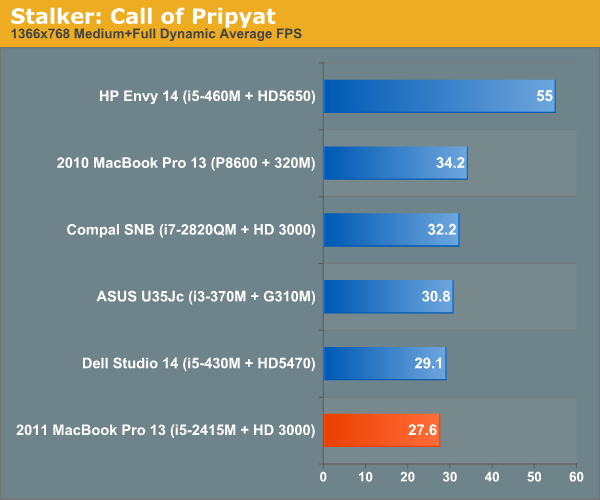
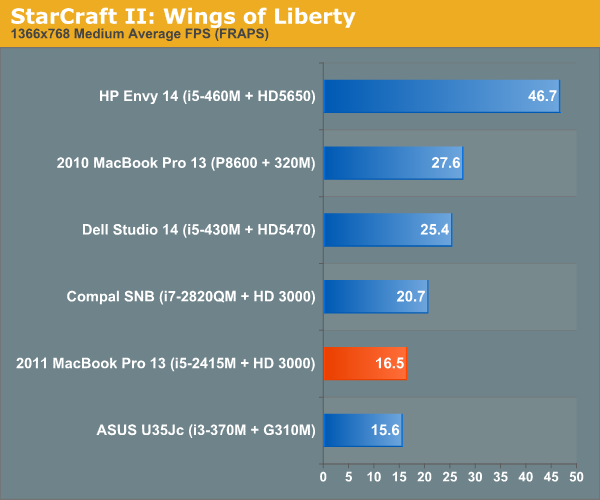
We see a similar result in the Cinebench 11.5 OpenGL test—a 24% decrease in performance relative to the old MBP.
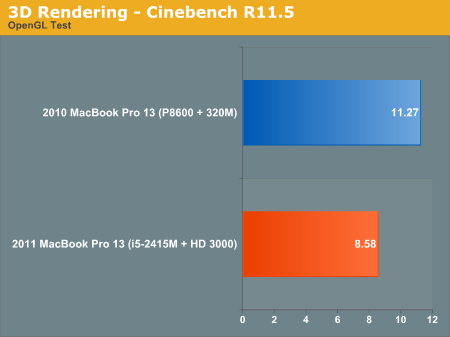
Given the huge leap in CPU performance, I'd have been okay if the graphics stayed on par with the previous MBP 13, but I was a little disappointed to see it that much slower. This is a weird one, since the same GPU gave us significantly better performance in the SNB test system. The only explanation we have has to do with turbo. The max turbo supported by the HD 3000 in the Core i5 2415M is 1.2GHz, down from 1.3GHz in the 2820QM. Now max clock speed isn't enough to explain this performance difference, but perhaps under Windows the 2415M's GPU doesn't turbo up quite as aggressively as the 2820QM's.
Anand consistently saw 10-15% faster results during the first run of a benchmark than the next four or five runs of the same test. This is probably due to thermal limitations—heat soak and overheating are pretty time-honored MBP traditions. However, my system shouldn't have been affected by thermal stress over time—I let it sit for some time between each benchmark run to let it cool, just to eliminate residual heat as a factor.
Based on CPU-Z, Apple isn't underclocking the GPU—it's running at the same 1.2GHz that's on the Intel spec sheets. The difference in performance is a little odd. The MacBook Pro, especially in 13-inch form, does have the potential to be thermally limited due to the size of the enclosure, but I'm not sure why a supposedly low-power graphics solution would be so thermally limited, even when testing to avoid the effects of heat build up as much as possible.










198 Comments
View All Comments
Anand Lal Shimpi - Friday, March 11, 2011 - link
Thank you for reading them, comments like this really do make it all worthwhile :)You wouldn't believe how much time was spent making sure Apple wasn't doing something funny with the max turbo frequencies. At the end of the day it was a non-issue, but we had to be sure.
Take care,
Anand
Ryan Smith - Friday, March 11, 2011 - link
Just to add some technical background to this, it's actually quite complex to get a CPU speed reading on modern CPUs. Mac OS X's Sysctl reports the base speed of the processor, regardless whether Turbo Mode is active or not. So on the 15" low-end QC model you will always see 2.3GHz.To actually read the instantaneous speed of any given core, you need to peek at the CPU itself and count the cycles - Intel actually has a handy document detailing an algorithm to do this(1). The issue with that is that it requires peeking at the Model-Specific Registers (MSRs), which require Ring 0 access; or in other words you need a broker at the driver level to do it.
Linux already does this (/proc/cpu/0/msr), and on Windows it's fairly trivial to load a driver alongside an Admin-level application to do this(CPU-Z, etc). Under Mac OS X this requires installing an Extension (at least as far as I know) which gets messy. If you don't go through this process you'll never be able to read the core speeds accurately, which is why there's virtually no Mac software capable of this.
Fortunately MSR Tools exists, and it has a 32bit extension to allow it to peek at the MSRs. The right answer of course is always the last answer you try, so this was only after trying several other ways of calculating the CPU speed and a couple different OS-agnostic benchmarks to try to rule out OS differences.
1) http://download.intel.com/design/processor/applnot...
tno - Friday, March 11, 2011 - link
+1I've been planning to plunge into Mac ownership for sometime, especially with grad school looming I really want something that's more comfortable to work on than my netbook but still fairly portable. This review really helped me gauge whether it was worth putting in the extra cost for a 2011 13" MBP or settle for a discounted 2010.
So am I all set? Hardly! Now I need to see what the 2011 13" MBA has to offer! I'm praying that cost stays roughly the same and a move to a ULV SNB leads to 12+ hour battery life and a similarly huge leap in performance as the move lead to in the MBP. I am a sucker for lightweight form factors.
This article is also the first one to make me ever consider the 15" MBP. I have been fairly opposed to the bulk but the performance is quite something. If I went that route then I would probably have a C2Q, water-cooled, ATI and SSD driven rig to put up on AT forums. Taking offers!
tno - Wednesday, May 4, 2011 - link
Rezzing a dead thread! I bought the 13" MBP! $999 at MicroCenter, too good to pass up! So . . . who wants my rig?JasperJanssen - Saturday, August 6, 2011 - link
I, on the other hand, have gone the other way. My MBA13 is being put together in China now.ltcommanderdata - Thursday, March 10, 2011 - link
A great review. I do have some additional questions though. First, given Apple was the instigator of OpenCL, it'd be great if you could run some OpenCL benchmarks. Are the Sandy Bridge MacBook Pro's disproportionately faster than the Arrandale MacBook Pro to indicate that OS X has CPU OpenCL drivers that can take advantage of AVX? Probably not, and this will hopefully come with Lion. Given nVidia's GPGPU push can the HD 6490 still keep up with the 330M GT in OpenCL? How does the HD6750 do?http://www.bit-tech.net/hardware/graphics/2011/01/...
"'[Intel] will be releasing OpenCL graphics drivers to developers during the course of 2011. [Intel] continue to evaluate when and where OpenCL will intercept various products"
And is there secret Sandy Bridge IGP OpenCL support? Bit-tech got a quote from Intel that Sandy Bridge IGP OpenCL support was inbound sometime this year and if anyone would be motivated to get it done it'd be Apple.
And finally, does Apple now support hardware H.264 decoding on ATI or Intel GPUs? Previously, only a few nVidia GPUs were supported in Snow Leopard, such that the Arrandale MacBook Pro actually had to power up the 330M GT to decode H.264 wasting power compared to the perfectly fine Arrandale IGP if Apple just wrote the drivers. Do the new Sandy Bridge have the ATI GPUs doing H.264 decoding now, is the Intel IGP supported, or in the worst case is no H.264 hardware acceleration available now that nVidia GPUs are gone? Perhaps lack of hardware H.264 decoding is what makes the FaceTime HD CPU usage so high? QuickSync is only accelerating the encoding phase?
Anand Lal Shimpi - Friday, March 11, 2011 - link
Some answers:1a) I don't know of any good GPU based OpenCL tests under OS X at this point. I'm not even sure if Apple's Intel HD 3000 driver supports OpenCL.
1b) Intel mentioned SNB's GPU technically supports OpenCL however there are no plans to release a public driver at this point.
2) Hardware H.264 decoding is enabled on the 2011s and it is used while FaceTiming, at least according to Apple.
Take care,
Anand
ltcommanderdata - Friday, March 11, 2011 - link
Thanks for the reply.http://www.macupdate.com/app/mac/33632/smallluxgpu
In regards to OpenCL testing, most people in OS X seem to use SmallLuxGPU which is an OpenCL raytracing benchmark. I don't have much experience with it, but it might be worth a try.
In regards to hardware H.264 decode, do you know if the IGP is doing it or does the discrete GPU still have to be powered up as in the 2010 Arrandale MacBook Pros?
Thanks
Anand Lal Shimpi - Friday, March 11, 2011 - link
It's my understanding that the IGP can do the decoding, although note that while FaceTime is running the dGPU is enabled by default.Good call on SLG, I had forgotten about that :)
Take care,
Anand
secretmanofagent - Thursday, March 10, 2011 - link
Hello authors,On one of the pages, you mentioned this:
"This isn't Mac specific advice, but if you've got a modern Mac notebook I'd highly recommend upgrading to an SSD before you even consider the new MacBook Pro. I've said this countless times in the past but an SSD is the single best upgrade you can do to your computer."
Is there an article where you recommend the best update for my model? Should I even bother with the drive? I realize the X3100 is going to still hamper any sort of graphical performance, but wondering if it's worth the effort.
Out of curiosity as well, would a Time Machine restore be possible if you update the drive?